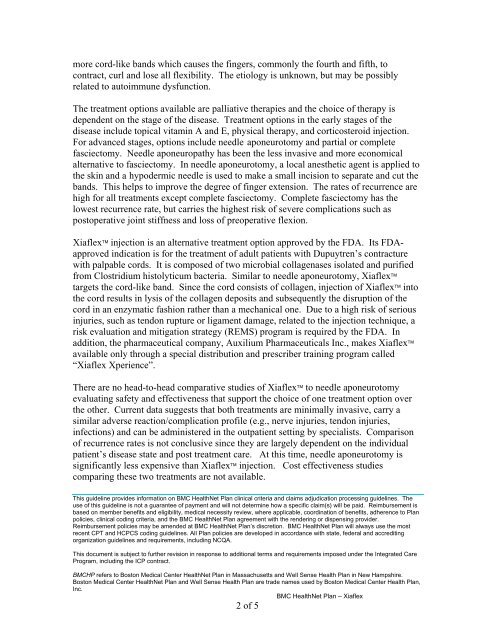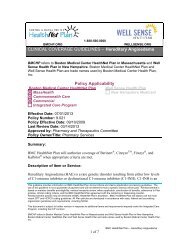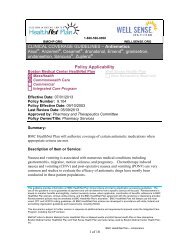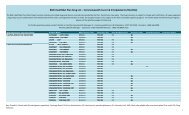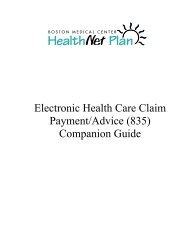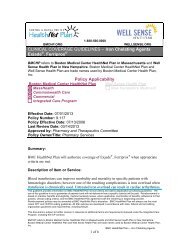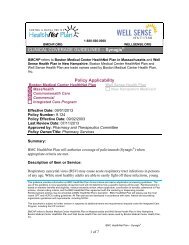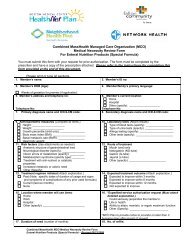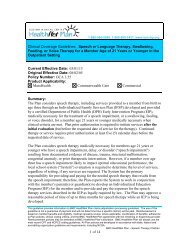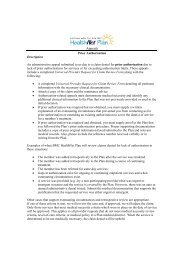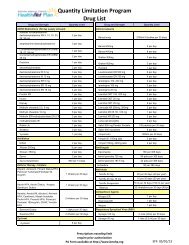Xiaflex - BMC HealthNet Plan
Xiaflex - BMC HealthNet Plan
Xiaflex - BMC HealthNet Plan
You also want an ePaper? Increase the reach of your titles
YUMPU automatically turns print PDFs into web optimized ePapers that Google loves.
more cord-like bands which causes the fingers, commonly the fourth and fifth, tocontract, curl and lose all flexibility. The etiology is unknown, but may be possiblyrelated to autoimmune dysfunction.The treatment options available are palliative therapies and the choice of therapy isdependent on the stage of the disease. Treatment options in the early stages of thedisease include topical vitamin A and E, physical therapy, and corticosteroid injection.For advanced stages, options include needle aponeurotomy and partial or completefasciectomy. Needle aponeuropathy has been the less invasive and more economicalalternative to fasciectomy. In needle aponeurotomy, a local anesthetic agent is applied tothe skin and a hypodermic needle is used to make a small incision to separate and cut thebands. This helps to improve the degree of finger extension. The rates of recurrence arehigh for all treatments except complete fasciectomy. Complete fasciectomy has thelowest recurrence rate, but carries the highest risk of severe complications such aspostoperative joint stiffness and loss of preoperative flexion.<strong>Xiaflex</strong> injection is an alternative treatment option approved by the FDA. Its FDAapprovedindication is for the treatment of adult patients with Dupuytren’s contracturewith palpable cords. It is composed of two microbial collagenases isolated and purifiedfrom Clostridium histolyticum bacteria. Similar to needle aponeurotomy, <strong>Xiaflex</strong>targets the cord-like band. Since the cord consists of collagen, injection of <strong>Xiaflex</strong> intothe cord results in lysis of the collagen deposits and subsequently the disruption of thecord in an enzymatic fashion rather than a mechanical one. Due to a high risk of seriousinjuries, such as tendon rupture or ligament damage, related to the injection technique, arisk evaluation and mitigation strategy (REMS) program is required by the FDA. Inaddition, the pharmaceutical company, Auxilium Pharmaceuticals Inc., makes <strong>Xiaflex</strong>available only through a special distribution and prescriber training program called“<strong>Xiaflex</strong> Xperience”.There are no head-to-head comparative studies of <strong>Xiaflex</strong> to needle aponeurotomyevaluating safety and effectiveness that support the choice of one treatment option overthe other. Current data suggests that both treatments are minimally invasive, carry asimilar adverse reaction/complication profile (e.g., nerve injuries, tendon injuries,infections) and can be administered in the outpatient setting by specialists. Comparisonof recurrence rates is not conclusive since they are largely dependent on the individualpatient’s disease state and post treatment care. At this time, needle aponeurotomy issignificantly less expensive than <strong>Xiaflex</strong> injection. Cost effectiveness studiescomparing these two treatments are not available.This guideline provides information on <strong>BMC</strong> <strong>HealthNet</strong> <strong>Plan</strong> clinical criteria and claims adjudication processing guidelines. Theuse of this guideline is not a guarantee of payment and will not determine how a specific claim(s) will be paid. Reimbursement isbased on member benefits and eligibility, medical necessity review, where applicable, coordination of benefits, adherence to <strong>Plan</strong>policies, clinical coding criteria, and the <strong>BMC</strong> <strong>HealthNet</strong> <strong>Plan</strong> agreement with the rendering or dispensing provider.Reimbursement policies may be amended at <strong>BMC</strong> <strong>HealthNet</strong> <strong>Plan</strong>’s discretion. <strong>BMC</strong> <strong>HealthNet</strong> <strong>Plan</strong> will always use the mostrecent CPT and HCPCS coding guidelines. All <strong>Plan</strong> policies are developed in accordance with state, federal and accreditingorganization guidelines and requirements, including NCQA.This document is subject to further revision in response to additional terms and requirements imposed under the Integrated CareProgram, including the ICP contract.<strong>BMC</strong>HP refers to Boston Medical Center <strong>HealthNet</strong> <strong>Plan</strong> in Massachusetts and Well Sense Health <strong>Plan</strong> in New Hampshire.Boston Medical Center <strong>HealthNet</strong> <strong>Plan</strong> and Well Sense Health <strong>Plan</strong> are trade names used by Boston Medical Center Health <strong>Plan</strong>,Inc.<strong>BMC</strong> <strong>HealthNet</strong> <strong>Plan</strong> – <strong>Xiaflex</strong>2 of 5


